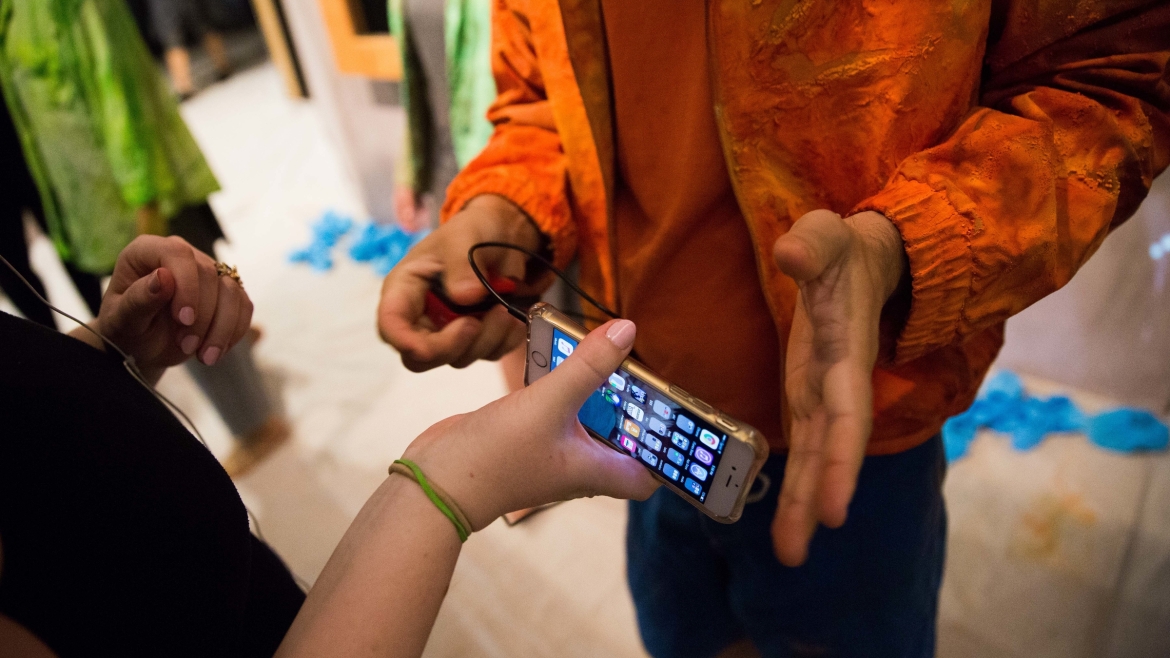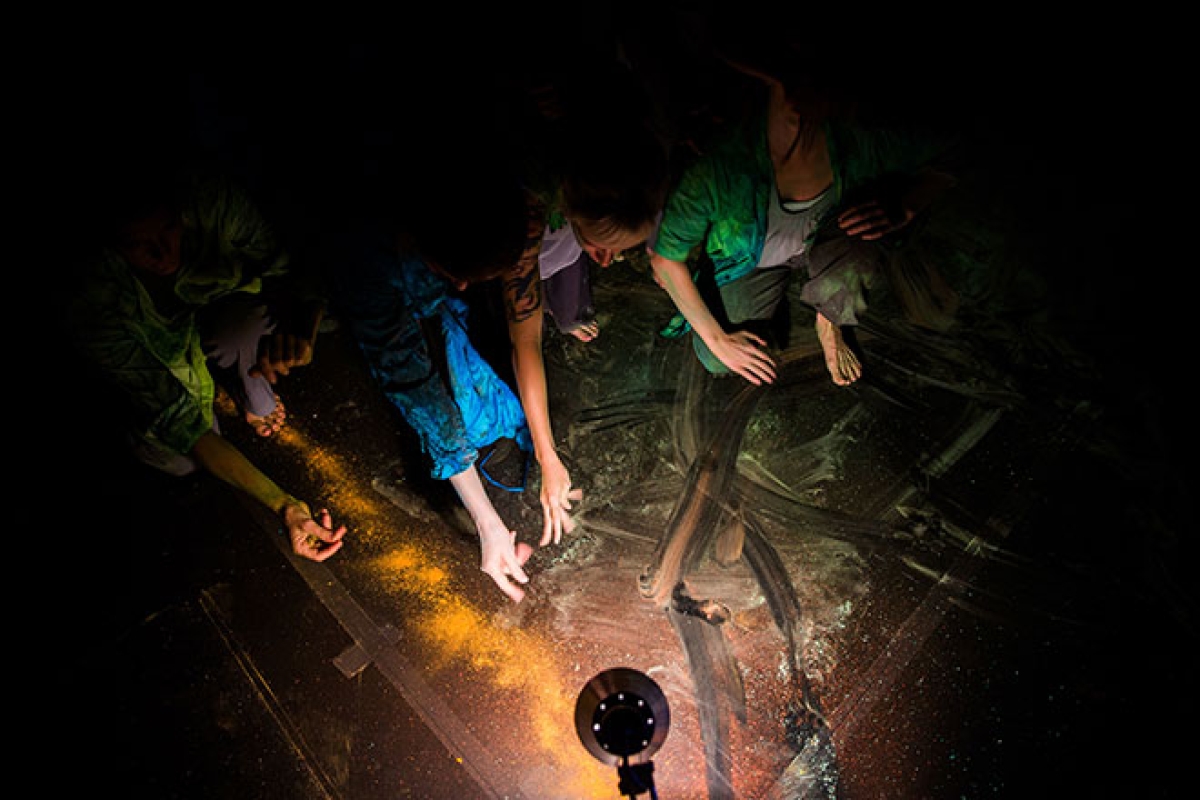Editor's note: This story is being highlighted in ASU Now's year in review. To read more top stories from 2015, click here.
Ask people to picture what data looks like and they might envision something like the opening title sequence of “The Matrix,” where boxy green code rains down a static black background. Ask them to imagine what it sounds like and they might recall the scene in the movie where Neo is traced and his scream devolves into a chaotic jumble of metallic sounds.
Thankfully, a few Arizona State University faculty have come up with a decidedly less terrifying way to experience data somatically.
This Friday, Jacqueline Wernimont, Jessica Rajko and Eileen Standley will present “Vibrant Lives and Data Archives,” an atypical performance installation that aims to inform people about the concept of personal “data shed” by providing an experience in which their data can be seen, felt and heard.
Data shed refers to the nearly 3.5 million bytes of data produced per person, per day. That data is unique to each person because it comes from things like smartphone apps or wearable fitness devices that record a person’s behavior and actions.
But it doesn’t stop at "Bejeweled Blitz" and Fitbits. Everything from the Facebook ads you click on to pacifiers that tell a baby’s temperature produce data.
“There’s all this data that’s flying off of us all the time, but you can’t see it,” said Wernimont, assistant professor in the Department of English whose research focuses on alternative ways of understanding data.
And all of that data, that personal information, is being captured.
Captured by whom and for what purpose, you might ask?
Mostly by mobile-app developers, who often sell it to third-party users, who in turn use the data to develop a profile of an individual in order to create customized consumer experiences.
Wernimont calls them “the guys in the closet.”
“[They] are watching everything that you’re doing and gathering data about that,” she said.
Though that might sound creepy, don’t break out the torches and pitchforks just yet.
Even though there are instances like the one where a father whose daughter had been killed in an auto accident received junk mail from a company that forgot to delete the data they had used to target him — resulting in the phrase “daughter killed in car crash” printed below his address — there are also ways that sharing personal information can benefit us.
“There are lots of instances where (sharing information is) useful. Devices like Fitbits. Those kinds of things are advertised as self-empowering technologies, and for lots and lots of people they really are,” Wernimont said. “So it’s not that they’re good or bad. It’s that they are. And understanding how they work allows us to understand how they shape the world that we see.”
One of the things Wernimont, Rajko and Standley hope to accomplish with “Vibrant Lives” is to give people a sense of the sheer amount of personal data they shed every day in a way that more effectively resonates with them.
“A lot of times data is represented in static form through visual presentations of graphs or charts, which is interesting, but doesn’t necessarily give an embodied experience of what that really means,” said Rajko, assistant professor in the School of Film, Dance and Theatre, part of the Herberger Institute for Design and the Arts.
Watch a video below of the performance in action Friday night.
Rajko met Wernimont after the latter had given a Nexus Lab presentation on her research. Intrigued, Rajko approached Wernimont and they got to talking. Later on, Standley — a clinical professor in the School of Film, Dance and Theatre — joined the mix.
The trio applied for and were awarded funding from a Herberger Institute seed grant as well as an Institute for Humanities Research seed grant to pursue the project that eventually became “Vibrant Lives,” and immediately got to work brainstorming how to illustrate their ideas.
With input from Jamie Winterton, director of strategy with ASU’s Global Security Initiative, they developed a mobile phone application to be used in conjunction with the performance installation.
Upon entering the performance space, attendees can download the app and, as they move through the space, their phones will vibrate or make sounds in direct relation to the amount of data they are producing, or “shedding.”
“How that works is we’re setting up an external server, or an external device, that’s basically capturing all the data in the space. It can identify whose data is being captured and then send that data amount back to the phone.
“So it’s almost sort of like this third-party system, which is sort of a redundant metaphor, I think, for some of the things we’ve been talking about,” Rajko said with a laugh.
Attendees will also have the opportunity to hook their phone up to a device called a woojer, which translates data into vibrations that can be felt.
“Vibrant Lives” will also feature a group of 20-plus performers made up of ASU students and alumni who will, in a sense, be acting out data.
To describe what that might look like, Wernimont references Wendy Chun, a media theorist at Brown University who says that “devices are promiscuous,” because, Wernimont said, “essentially what they’re doing is saying, ‘Hey! Hey! Hey! Hey!’ to the Internet. And the Internet is like, ‘Are you there? Are you there? Are you there? Are you there?’ ”
So attendees can expect a certain amount of interaction with the "Vibrant Lives" performers. They will be clad in costumes coated in colored cornstarch, which will shed particles as they move, reiterating the idea of data shed.

“There’ll be dancers talking to you, or offering you a kinesthetic experience, depending on the level of engagement that the audience wants to (engage in),” Standley said.
She added that “the process becomes a teaching setting in many ways. As well as providing a bridge to the Arizona community and local professional arts setting, students learn from working with us and are also informed in deep ways about the concepts we are researching together.”
The fact that humans play a role in demonstrating what data might look is no accident.
“By having bodies in the room that are interacting with people, we’re making an active argument that this is about people,” Wernimont said. “What you’re feeling vibrate is a person.”
Rajko expounded on that, “Everybody has a body, and human-based data is not possible without humans. So ultimately, if we’re looking at a graph or a chart with data points … that’s not possible without people.
“And so how do we take the distraction of something that separates those two out and bring it back to this?” she asked, reaching out to Wernimont sitting next to her and placing her hands on Wernimont’s arm. “Because ultimately, this is what it’s about.”
“Vibrant Lives and Data Archives” will premier at 6 p.m. Friday, Oct. 2, in ASU’s Galvin Playhouse. The installation is a “pre-show” that will begin 30 minutes before each performance of Fall Forward!, the kick-off event of Herberger’s dance season, featuring new works created by ASU faculty and guests.
Though this particular iteration of the performance installation focuses on animating a person’s individual data, plans are in the works for future performances that will look at aggregate data — data taken from a group of people.
“This is like a tiny little segment of the bigger project,” Wernimont said.
“Vibrant Lives” will travel this summer to the Digital Humanities Summer Institute in Victoria, British Columbia, and later will showcase at Spark! Mesa’s Festival of Creativity in March 2016, where it will feature an added sculptural element composed of what are basically giant woojers, called ButtKickers.
Each performance will build on and make changes to the previous one.
“It’s really important that this is a demonstration of the ways in which art performance is research. Creative and performative is the same as research. This is our lab,” said Wernimont.
More Arts, humanities and education

ASU instructor’s debut novel becomes a bestseller on Amazon
Desiree Prieto Groft’s newly released novel "Girl, Unemployed" focuses on women and work — a subject close to Groft’s heart.“I have always been obsessed with women and jobs,” said Groft, a writing…

‘It all started at ASU’: Football player, theater alum makes the big screen
For filmmaker Ben Fritz, everything is about connection, relationships and overcoming expectations. “It’s about seeing people beyond how they see themselves,” he said. “When you create a space…

Lost languages mean lost cultures
By Alyssa Arns and Kristen LaRue-SandlerWhat if your language disappeared?Over the span of human existence, civilizations have come and gone. For many, the absence of written records means we know…








